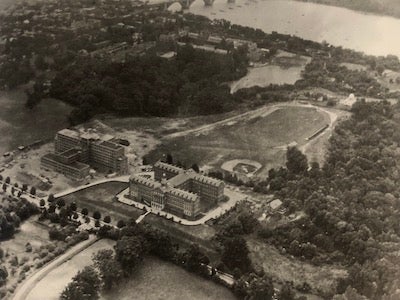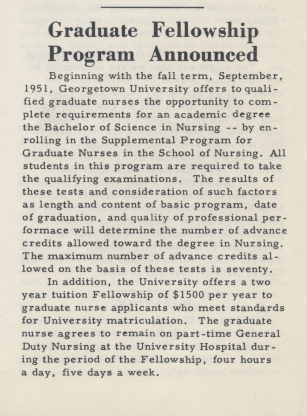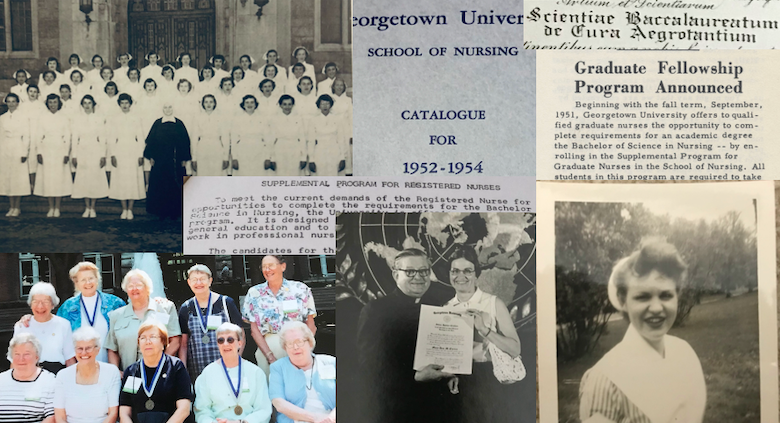Georgetown Alumna Received 3-Year Nursing Diploma in 1949 and BSN Degree in 1953 Through New ‘Supplemental Program’
January 4, 2021 – In the early 1950s, Mary Anne (Maryman) Curtis, who had already received the three-year diploma at Georgetown in 1949, decided to return to the university to complete the bachelor of science in nursing (BSN) degree.
“I lived way over on the other side of town,” she said. “So, I’m taking buses and streetcars over to Georgetown until I got a job that gave me a little money. Then I bought myself a car. Things were different in those days.”
Back then, Mrs. Curtis enrolled in a new program Georgetown’s School of Nursing had launched in the fall of 1951 called the “supplemental program,” through which “graduate nurses” who held a diploma and a registered nurse license could attain the baccalaureate degree in nursing through additional coursework.
“I saw the writing on the wall and that it was going to be necessary to have a degree,” said Mrs. Curtis, whose name appeared with the BSN graduating Class of 1953 in the university’s Commencement program. Her diploma from that year read, scientiae baccalaureatum de cura aegrotantium, which translates to, “bachelor of science in care of the ill.”

Virtual Reminiscing
One recent afternoon, Mrs. Curtis and her husband Mr. Donald Curtis, now both in their early 90s, sat down for a phone conversation with this author.
The couple said they are enjoying living in a retirement community of nearly 300 people in Massachusetts. While COVID-19 has limited their socializing, they are grateful to be around and participating in group activities with others. “It’s like almost going back to college, but not exactly,” Mrs. Curtis joked. “We don’t have to study.”
The two met in Washington in the 1950s at an event for alumni of Catholic universities, and they have five children and many grandchildren and great-grandchildren. Mr. Curtis, a 1953 Notre Dame graduate, completed his memoirs during the pandemic – which he gave to their children for Christmas.
While the passage of more than 70 years has obscured – not surprisingly – exact details of dates, locations, and names, Mrs. Curtis took the time to share some memories and reflections from this period of her life.
Deciding on Georgetown
Mrs. Curtis attended the Academy of Notre Dame, an all-girls Catholic school that was near Gonzaga College High School. So, she was familiar with the Jesuits.
“Well, I wanted to go to a Catholic nursing school, and there were only two in town,” she said when asked how she chose Georgetown. “This was really kind of stupid: I remember going with my mother, and we went over to the first one, and it was rainy that day. It didn’t show up. It was old, very old. . . . Then I went the next day to Georgetown, and it was bright and sunny. Georgetown was brand new, brand new, had just really opened. . . . So I said, ‘Well I’m going to go here. That’s how I got to Georgetown.’”
What Mrs. Curtis might be recalling – in terms of newness – is a nursing dormitory that had just opened in June of 1945 around Prospect and N Streets, according to Dr. Alma Woolley’s Learning, Faith, and Caring: History of the Georgetown University School of Nursing, 1903-2000 (2001). It wasn’t until 1947 that the new hospital on Reservoir Road began operating.
She remembered living in a residence hall on Prospect, as well as in the old hospital itself. In terms of the dorm’s location, she said, “From the main street down low, there’s a stairway that comes up.”
This author mentioned that that stairway between M and Prospect Streets is now referred to as the Exorcist steps, after the 1973 horror film, ones Mrs. Curtis aptly called, “the steps, those steep steps.”
‘We Did Everything’
One story – from early on in her nursing school education – stood out for Mrs. Curtis. “We did regular nursing,” she said. “I can remember one of the first times when I was on, I think it was night duty. . . . I was with another nurse, and they had a lady that died, and we didn’t know what the heck to do. We were brand new. We had just started out. We hadn’t had much education.”

Mr. Curtis asked his wife about the kinds of responsibilities nursing students had in the hospital. She simply replied, “We did everything. Yes, yes, we did everything.”
This author also later inquired about the capping ceremony and its location on campus.
“That was a big part of it was your capping – that was a big thing,” she said. “I can’t remember exactly where we did it, but we had our capping. Yeah, that’s always been a thing with the nurses . . . . But we got it before we were finished the program. You went through a certain part, and then you were capped.”
Recalling the significance of the licensing exam to become a registered nurse, Mrs. Curtis added, “Then you had to finish the program and take your boards. Oh boy.”
‘We Were Happy’
Mrs. Curtis discussed the sisters who ran the nursing program, indicating her sense that during her early studies there was both a change in the sisters and administrative control of the school.
This author mentioned the names of two religious communities who had been involved with Georgetown’s hospital and nursing school at the time: the Sisters of Saint Francis being the first, from 1898-1947, and the Sisters of Charity of Nazareth, who began in 1947.
“I came in in September, and I came in with the first group,” Mrs. Curtis shared. “And by, I think, the first of the year, we became officially Georgetown School of Nursing, and . . . the second group – they were the ones that ran it.”
During the conversation, she also recalled – with laughter – some frivolity with friends from those years. “We’d sneak out at night,” she said. “‘We snuck out tonight to get our beers’ and stuff like that.”
At one point, Mr. Curtis knowingly mentioned, “[You] also did smoking, too, didn’t you?” “Oh, yeah, we weren’t supposed to smoke, but we snuck that, too,” Mrs. Curtis responded, confessing the students smoked in their rooms. “We had an older person that was in charge, and we could put pretty much anything over her head.”

Yet she admitted, “We didn’t fool around too much with the nuns. But the nuns, they were good. I kept up with them for a lot of years.”
Asked about student life, she later commented, “We were very social, probably more social than those sisters wanted. We weren’t supposed to smoke, and the girls smoked. We snuck a lot of stuff. We were happy, normal young people.”
Reflecting physical changes to Georgetown since then, Mrs. Curtis described how the walk from the original hospital complex around 35th Street – where the nursing students lived – around campus and to the new hospital on Reservoir Road took them along unfinished pathways through the trees.
Cadet Nurse Corps
During the Second World War, federal legislation created a program to support the nursing workforce for military and non-military settings. Georgetown, historians and archival materials described, took part in that program, which included paid tuition.
“The Cadet Nurse Corps was during the war,” Mrs. Curtis remembered. “I went into the nursing school the year after the war, and there was a big feeling between the ones ahead of us, because they could go free and we had to pay. So my class was the first one that went through that had to pay.”
Woolley’s history also indicated that the last Cadet class had finished their diplomas in 1948, meaning they had entered in 1945, the year before Mrs. Curtis’ class began.
Fellowship Student
A 1952-1954 catalog for the School of Nursing, housed in the university’s archives, listed the names of enrolled students for the supplemental (now commonly called “RN-to-BSN”) program. Mrs. Curtis is included among the fellowship students, and she remembered working night duty.

Mrs. Curtis explained, “I think they paid our whole way. I think we went for nothing to finish up. It was a special program because at that point, Georgetown didn’t have any, really graduates with a degree, and they wanted graduates with a degree.”
The December 1951 issue of the nursing student publication Starch and Stripes ran a front-page story about the supplemental program that said the two-year fellowship, in exchange for working in Georgetown’s hospital “four hours a day, five days a week,” annually provided $1,500 to students.
“I had started another program at another hospital because Georgetown didn’t have it,” Mrs. Curtis said. “Then I quit that one and went to the Georgetown program, and I graduated with a degree from Georgetown, a degree from the College. It wasn’t like what we had, just a school of nursing, back in the old days.”
Later, she added, “There were people from other nursing schools that went through that, too. They weren’t just Georgetown graduates, but they were all graduate nurses.”
College Coursework
During her studies, Mrs. Curtis took English and history courses in addition to the nursing-focused classes. A brochure in the Georgetown’s Archives from 1944-1945 outlined the three-year diploma curriculum, which included English, ethics, nursing history, and religion.
This author asked if courses were co-educational. “Yeah,” she said, “those later classes, some of them were with men, but not a lot of them.” Through the supplemental program, Mrs. Curtis said she took courses with students on Georgetown’s campus.
“When I took English and history, things like that, I was taking them up at the College with the College students,” Mrs. Curtis said. “And they were men, so we were mixed with them in classes. But that was after I’d finished my nursing. I was a registered nurse, and I was working as a nurse, but when I was on that special program and taking these classes up at the university, they were with men and women . . . .”
Later, this author inquired whether Mrs. Curtis thought the male students were fine with the presence of women in classes. “No, I don’t think there was any bad feelings about it. I think they enjoyed it,” she said.
‘Name That People Recognize’
Mr. and Mrs. Curtis attended many Georgetown reunions to visit with old friends.

“We went to yours because your parents were living in Washington and they could take care of the kids while we went to the reunion,” Mr. Curtis said. “It was just a small group of the nurses, pretty much, that socialized together. There were about a dozen of them and their husbands, and so it was a nice little social group for the reunion. . . . We went to some of the reunion events and the meals, and things like that. It was a good time to go, a fun time.”
When asked if she felt the BSN degree has been beneficial to her, Mrs. Curtis replied, “Oh, yes. Of course, it did, because a lot of people didn’t have it, and it opened doors to me – like when I came up to Massachusetts. To get a job, I could get a better job because I had a degree, particularly from Georgetown.”
Mr. Curtis said that the sisters who ran a nursing home in Massachusetts where Mrs. Curtis worked were impressed by his wife’s Georgetown credentials when she was applying for the job.
Even today – seven decades after her studies at Georgetown – it still makes her proud.
“I go around [our community] and talk to people that graduated from nursing when I did,” Mrs. Curtis said. “And they’ve heard of Georgetown. I just had to say, ‘Georgetown.’ They said, ‘You graduated from Georgetown?’ I said, ‘Yeah, it was a hometown school,’ which it was. But it’s still got a name that people recognize.”
By Bill Cessato
The author is very grateful to Mr. and Mrs. Curtis for spending time with him sharing memories and reviewing drafts of this article and to their daughter for sending photos. Thanks to Dr. Charles McNelis of Georgetown’s Classics Department for helping out with the Latin degree translation.
More Reading
Dr. Alma Woolley’s Learning, Faith, and Caring: History of the Georgetown University School of Nursing, 1903-2000 (2001) for information about the history of the nursing school, including the diploma program, the origins and various versions of the supplemental program (including supplemental students taking university courses), the sisters, the Cadet Nurse Corps, the hospital, buildings, and timelines.
Dr. Robert Emmett Curran’s A History of Georgetown University: The Quest for Excellence 1889-1964 (2010) for Georgetown and nursing school history from 1903 through the 1960s, including the supplemental program, the Cadet Nurse Corps, and College professors, in the 1940s, starting to teach nursing students humanities- and science-based subjects.
Click here to read other recent articles about Georgetown nursing history.
- Tagged
- Nursing History

